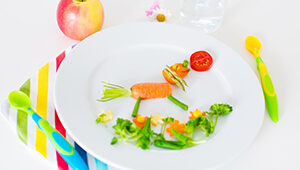Color Their World


Recent studies have shown that less than 15 percent of kids ages 6 through 12 eat five servings of fruits and vegetables a day, and a quarter of the vegetables they eat are French fries! To meet the dietary guidelines, fruits and vegetables should take about half the space on a child’s plate.
Like Parent, Like Child
The different colors of fruits and vegetables signify different combinations of nutrients. That’s why it’s important for children, and their parents, to choose from a variety of purple, orange/yellow, red, green, and white produce daily. “Parents are their children’s role models, so they should also eat plenty of fruits and vegetables every day,” Tanner says.
Feed Your Child’s Food Personality
At mealtime, is your child a Plain Jane, Saucy Sam, or Dunking Debbie? If you sit across from a Plain Jane who likes her foods unadorned, serve vegetables and fruits without sauces or toppings. To make your Saucy Sam smile, top his vegetables with spaghetti sauce or low-calorie salad dressing. And go for a slam dunk by dealing your Dunking Debbie a dip of plain yogurt and salad dressing mix alongside her vegetables.
In addition to their preference for sauces, children also may react to the texture of a vegetable. “If your child is sensitive to mushy vegetables, cook just enough to soften them, yet still retain their crunch,” says Lorelei DiSogra, R.D., Ed.D. director of the National Cancer Institute 5 A Day Program.
Hands On
Children who “play” with fruits and vegetables are more likely to eat them. Involve your child in shopping for new fruits and vegetables to try, arranging vegetables on a platter, creating vegetable kabobs, or tossing a fruit salad. Offer to work with your child’s teacher on a vegetable garden project.
“Research shows that children who learn about vegetables and fruits, especially in a school setting, are more likely to eat them,” DiSogra says.
Mindy Hermann, M.B.A., R.D., has 15-year old twins who now love fruits and vegetables.
10 Fruit & Veggie Boosters
- Keep the crunch by lightly steaming or microwave cooking vegetables.
- Make fruits and vegetables fun-use shaped melon-ball scoops and hors d’oeuvre cutters to jazz up a fruit salad. Or decorate pizza or pasta with broccoli trees, mushroom toadstools, carrot logs, or other vegetable shapes.
- Talk to your school’s food service provider about offering more fruit and vegetable choices.
- Encourage your children to order kid-friendly vegetable dishes at restaurants, such as vegetable soup or stir-fried vegetables.
- Wash, peel, and cut up vegetables so they’re ready to eat. Keep them in a re-sealable plastic bag or container in the refrigerator.
- Involve children in vegetable- and fruit-related projects such as gardening and farm visits.
- Create a rainbow sticker calendar and let your child add stickers for each serving of fruits and vegetables he or she eats in a day.
- Serve at least one vegetable or fruit at each meal or snack.
- Give children a choice of fruits and vegetables, especially when serving one that’s new to them.
- Ask your child to try just one bite when you’re serving an unfamiliar fruit or vegetable and be patient!


